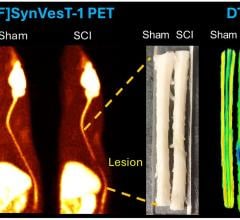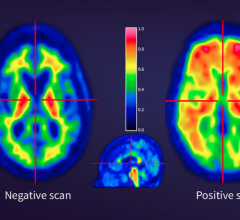
Figure 1. Tau accumulation over one year measured in composite A) mesial temporal ROI; and B) temporoparietal ROI in cognitively unimpaired participants (blue) and cognitively impaired participants (red). The CI group included participants with clinical mild cognitive impairment and dementia. Higher rates of tau accumulation were observed in participants on the AD continuum (CU Aβ+ve and CI Aβ+ve). Participants with the highest baseline tau and rates of tau accumulation were younger and more likely to be CI Aβ+ve. Image courtesy of SNMMI
June 16, 2021 — A novel positron emission tomography (PET) radiotracer has been shown to effectively measure increases in brain tau—a distinguishing characteristic of Alzheimer’s disease—before any symptoms of the disease are observed. With the potential to measure increases in tau over a long period of time, this tracer offers an important tool to assess the effectiveness of Alzheimer’s disease treatments in clinical trials. This research was presented at the Society of Nuclear Medicine and Molecular Imaging 2021 Annual Meeting.
Tau is a protein commonly found in healthy brain neurons. In people with certain brain disorders, like Alzheimer’s disease, chemical changes cause tau proteins to accumulate in various parts of the brain. As such, tau is valuable as a biomarker for measuring disease progression.
In the study, researchers sought to detect patterns and rates of tau accumulation in both a cognitively normal aging population and in those with Alzheimer’s disease. PET imaging with the novel radiotracer 18F-MK6240 was performed on all participants at baseline and after 12 months. After each scan, uptake of the radiotracer was measured in multiple areas of the brain.
Increases in tau were measured in both participant groups and longitudinal tau imaging was effective in discriminating between the two cohorts. The uptake of 18F-MK6240 was higher at baseline and after one year in participants who were on the Alzheimer’s disease continuum in comparison to the cognitively normal aging participants.
“The effectiveness of the 18F-MK6240 tracer is important for drug trials that aim to measure whether or not treatments to remove tau from the brain are actually working,” said Christopher Rowe, BMBS, FRACP, MD, FAANMS, director of molecular imaging research at Austin Health and director of the Australian Dementia Network in Melbourne, Australia. “Use of the radiotracer will allow researchers to select people at different stages of Alzheimer’s disease for clinical trials, which ultimately may speed the development of effective treatments for the disease.”
For more information: www.snmmi.org
More news from SNMMI21 can be found here
Related Alzheimers' content:
VIDEO: Researchers Use MRI to Predict Alzheimer's Disease
Brain Iron Accumulation Linked to Cognitive Decline in Alzheimer's Patients
Good Results for Alzheimer’s Imaging Agent
NIH Augments Large Scale Study of Alzheimer’s Disease Biomarkers
Alzheimer’s Association Launches New Website for IDEAS Study
PET Tracer Gauges Effectiveness of Promising Alzheimer's Treatment
New Super-resolution Technique Allows for More Detailed Brain Imaging


 November 18, 2025
November 18, 2025 









